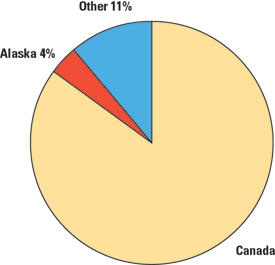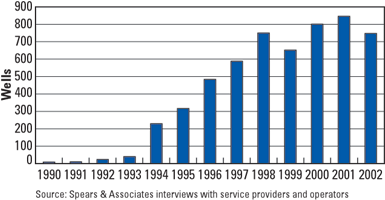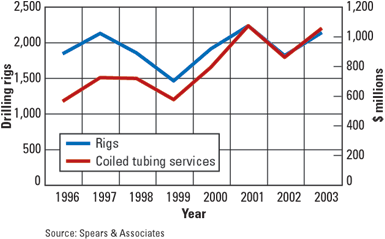Coiled Tubing Technology
US firms could follow Canada’s lead in coiled tubing drilling
Expansion in coiled tubing drilling is slowing, but its use in reentry drilling remains strong, and a DOE microhole drilling initiative may provide a boost.
Robert E. Snyder, Executive Engineering Editor, World Oil, for Spears & Associates, Inc., Tulsa, Oklahoma
Drilling with coil is fairly mature. Industry experts say that many service companies have drilled with coil, but most drill only one or two holes per year. Alaskan fields have used it for over 10 years and, although many predicted it, a significant offshore market never developed. Canada is by far the world leader in development and use of coiled tubing drilling (CTD), but an ongoing DOE project hopes to apply CTD to very slim holes.
THE CTD MARKET
In the US, only about 25 wells are drilled each year using coiled tubing. Canada accounts for over 90% of worldwide CT drilling, with 85% of North American CTD wells, Fig. 1. Even so, CTD plateaued a few years ago. Table 1 shows how the coiled tubing market is divided, for all uses, including drilling. It is possible that the “others” category in the table could be larger by as many as 200; Russia and China are not included. Most of the Canadian CT wells are simple vertical, non-steered holes. Higher cost re-entries occur in Alaska and the North Sea. The US Lower 48 has seen about 300 CTD wells to date.
 |
Fig. 1. Location of CTD wells (primary data source is Alex Sas-Jaworski)
|
|
| |
TABLE 1. Breakdown of the present coiled tubing fleet |
|
| |
Units |
Service company |
|
| |
|
|
| |
200 |
Schlumberger |
|
| |
165 |
BJ Services |
|
| |
105 |
Halliburton |
|
| |
38 |
Superior Energy Services |
|
| |
23 |
Cudd Pressure Control |
|
| |
11 |
Precision Drilling |
|
| |
6 |
Technicoil |
|
| |
5 |
Tucker Energy Services |
|
| |
5 |
Saber Energy Services |
|
| |
4 |
Advanced Coiled Tubing |
|
| |
3 |
Baker Hughes Inteq |
|
| |
210 |
Others |
|
| |
|
|
| |
775 |
Total |
|
|
Canada. Operators in Canada often use coiled tubing to drill slim and standard-sized holes. Canada drills 10,000 to 20,000 shallow wells per year, of which hundreds are drilled with CT. At year-end 2003, about 7,000 wells, cumulatively, had been drilled with CT, with about 750 to 850 being added each year, over 90% of worldwide CT drilling, Fig. 2. The most active CTD contractor is Precision Drilling in Canada. With 11 units pursuing work, the company can drill about 500 to 1,000 holes each year. Comparing the minimum location size (footprint) of CT units with small conventional drilling rigs, CT clearly has the size advantage: well sites are only one-quarter to one-third the size of a conventionally drilled pad. Along with smaller footprints, fewer loads are required to deliver equipment. The conventional rig requires about 27 loads in winter; the CT unit only about nine.
 |
Fig. 2. Annual coiled tubing drilled wells.
|
|
Drilling re-entry wells. Entering an existing well and drilling laterally from the wellbore, primarily from land wells and in marginally economic fields, may include one or more laterals. Additionally, re-entry may involve simply drilling straight down through the bottom of the casing and continuing the hole vertically. Re-entry drilling has become quite popular in recent years throughout the US. On any day, 50 to 100 of these rotary operations are occurring. Producers in Alaska always have two CT-based re-entry operations going on at the same time year round.
According to Spears & Associates, Inc. (SAI) research, re-entry drilling has been climbing since the mid-90s, standing now at almost 2,200 wells per year. It expects the number to peak in 2004 as standard drilling tops out, falling in 2005 before re-entry activity resumes its growth. Fields across the US are candidates for CT re-entry drilling.
PRESENT STATE OF COILED TUBING TECHNOLOGY
SAI’s past work indicated that CT services can be broken into two categories: production and drilling. Coiled tubing expands its applications by a few percent each year, so its overall market is growing. The improving quality of the tube itself and the predictability of its performance have won it increasing demand in new applications. Credibility is improving and Canada is leading the world in innovative CT use.
During the 2000-2001 uptick in the oilfield services market, conventional CT services, which represent 75% of CT spending, were growing about 10% to 12% per year, while fracturing and drilling were growing 30%. This move toward drilling and stimulation has been driving demand for larger diameter pipe.
Coiled tubing services doubled from 1999 to 2001, as the US moved toward gas well drilling and as a result of a trend toward completing wells under pressure. Conventional well servicing rigs were also booked up during the 2001 period. The recovery in drilling in 2003 allowed sales to further increase. When CT services revenues are plotted against active US drilling rig count, it is seen that sales of CT services are growing at a rate faster than the rig count, Fig. 3.
 |
Fig. 3. Value of coiled tubing services relative to conventional rigs.
|
|
Although coiled tubing’s past growth has been more robust than the general oil field, it appears that CT service is no longer a high growth market, given how technology development has slowed in recent years. Without an enhancement to the technology, be it microhole technology or something else, CT services will grow slowly, subject to the usual cyclic market forces.
Cost of drilling. Alaska’s producers report that the cost of re-entering a well with CTD is about one-third the cost of drilling a new well conventionally. As a rule of thumb, as well depth increases, the per-foot cost rises logarithmically. Comparing the costs of conventional and CT drilling, other than re-entry wells in Alaska and other places, few new wells have been drilled in the US with coil, so data is scarce. Conversely, thousands of such wells have been drilled in Canada. Although the comparison is not exactly “apples to apples,” the estimated per-foot costs of drilling a 3,000-ft MidContinent well with a conventional rig and a Canadian well with a coiled tubing rig are shown in Table 2 with the following conditions. Both wells have surface pipe set at 300 ft. The MidContinent production string is 4.5 in. and the Canadian string is 2-7/8 in. Cement, drilling fluids, logging, site preparation and damages, logistics, fuel, production tubing, etc. are included in Other.
| |
TABLE 2. Comparison of costs of conventional and CT drilling, 3,000-ft hole. |
|
| |
Region |
Contractor |
Pipe |
Other |
Total |
|
| |
|
|
| |
Mid-Cont. rotary |
$15 |
$5 |
$23 |
$43 |
|
| |
Canada CTD |
$15 |
$4 |
$14 |
$33 |
|
|
Comprehensive data has been assembled from a Joint Association Survey concerning US regional drilling cost information. These per-foot average costs have been married with the projected number of wells in each region for 2003 to yield the amount of money to be spent that year on drilling and completing wells in the US. These averages mask a wide range of actual costs, but the numbers give strong guidance regarding the money spent on drilling. The data indicates US operators spent $22.261 billion on drilling in 2003.
CT MICROHOLE DRILLING
A DOE-backed project to make microhole drilling an economic reality is well underway (see World Oil, December 2004). Some relevant information for using CT to drill very slim, or microholes (£ 3-1/2 in.) is presented here.
Drilling shallow development wells. Independent oil/gas producers are particularly interested in using CT for to reduce the cost of shallow (< 5,000 ft) development wells. This type of drilling, should it prove successful, would reduce costs, simplify logistics and improve asset performance.
CT drilling reservoir and seismic data holes. This application would use a CT-based drilling system to punch vertical holes to 6,000 ft for gathering: 1) seismic/VSP data; 2) reservoir pressure/ temperature data; 3) rock samples; and 4) fluid samples. The hole would be similar in size for a microhole intended for production, but production issues would not be of concern. Data sampling technologies are being developed.
Independents do not have the money to drill reservoir-monitoring holes. There is not a clamor for data-gathering holes. SAI believes that the initial customer for such holes will be the larger oil and gas producers and, once costs decline and the technology is proved up, progressively smaller independents will see the value of improved reservoir information
For this technology, in all its forms, to be commercialized, operators will need to insist that the service be made available. Service firms are not enthusiastic about the idea of charging less for a service without boosting sales volume, since this cuts into revenue and hurts return on service-company assets. Therefore, Spears & Associates, Inc. (SAI) does not expect service companies to be the initial, strong advocates for microhole technology. 
ACKNOWLEDGMENT
This article was mainly derived from, US Department of Energy microdrill initiative – initial market evaluation, a 45-page report from Spears & Associates, commissioned by the DOE. The report detailed the state of coiled tubing drilling and provided background information for a highly productive Albuquerque, New Mexico, workshop. For those interested in pursuing the entire document further, copies can be obtained at: sai@spearsresearch.com.
|





